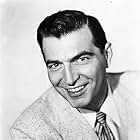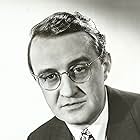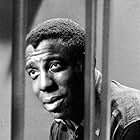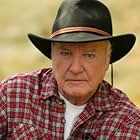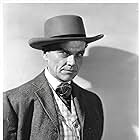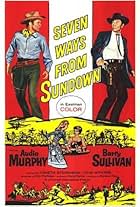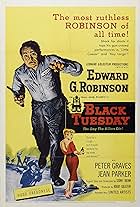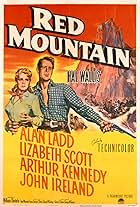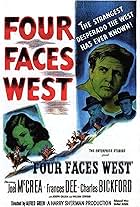NOTE IMDb
6,5/10
972
MA NOTE
Ajouter une intrigue dans votre langueA gambler is thrown out of a western town, but returns when the town is suddenly threatened by a band of marauding Apaches.A gambler is thrown out of a western town, but returns when the town is suddenly threatened by a band of marauding Apaches.A gambler is thrown out of a western town, but returns when the town is suddenly threatened by a band of marauding Apaches.
Gertrude Astor
- Townswoman
- (non crédité)
Bill Clark
- Townsman
- (non crédité)
Noreen Corcoran
- Child
- (non crédité)
Mason Alan Dinehart
- Child
- (non crédité)
Steve Dunhill
- Bob, a Townsman
- (non crédité)
Histoire
Le saviez-vous
- AnecdotesThe "Apache" Indians are actually lifeguards from the beach at Santa Monica, California, painted with full body paint and made up to look like Apaches. Director Hugo Fregonese and producer Val Lewton wanted the Apaches to do a lot of leaping from high windows, off of roofs, etc., and the film's budget precluded hiring stuntmen to play the Apaches. They decided to hire the lifeguards because of their athleticism and, more importantly, the fact that they didn't have to get stuntmen's pay.
- GaffesThe Apache are shown beating the drums with their hands, whereas they and all Native Americans used sticks or drum beaters.
- Citations
Rev. Griffin: If I live to bury Joe Madden, I'll say only four words over his grave: This was a man.
- ConnexionsFeatured in Val Lewton: The Man in the Shadows (2007)
Commentaire à la une
APACHE DRUMS (1951) is a routine western about Apaches on the warpath attacking isolated townsfolk in Arizona in 1880. A fairly low-budget film in color from Universal Pictures, it's something of a disappointment considering it was the final production of Val Lewton, the celebrated RKO producer who'd revolutionized the horror genre in the early-to-mid-1940s with such releases as CAT PEOPLE, I WALKED WITH A ZOMBIE and THE BODY SNATCHER. While there are some interesting atmospheric touches and dramatic moments, the film is ultimately undone by a talky script that fails to generate much suspense.
It focuses on a group of disparate characters in the town of Spanish Boot, with Sam Leeds (Stephen McNally), an itinerant gambler, emerging as the hero when, after being evicted from town by the upright blacksmith/mayor, Joe Madden (Willard Parker), he returns to warn them of the impending Apache attack. When the Apaches launch their big assault, all the townsfolk, including a contingent of Welsh miners, and a few soldiers hole up in the thick-walled adobe church and try to fend off entrance by Indians through the high windows. From the moment of the doors being locked, the entire remainder of the film (about 25 minutes) is from the point-of-view inside the church. Such a situation lends itself to great tension and there are some harrowing moments as the defenders stumble about in darkness and scramble for candles so they can see the Indians when they attack. Some of the fighting from this point is frenzied hand-to-hand combat in semi-darkness. One stirring moment comes when the townsfolk, frightened and intimidated by the strains of the Apaches' war song, decide to respond with a Welsh fighting song of their own.
The suspense is undercut, however, by frequent lulls in the action, with too much talk and a pointless love triangle involving Sam, Joe and Sally (Coleen Gray), the young woman who runs the local boardinghouse for the Welsh miners. The Indians also spend far too little time fighting. They bring their drums with them and launch into a whole drumming-and-chanting number before the attack on the church, something I've never heard Apaches do in a western before (or since) and something I don't think Cochise or Geronimo, to name two famous Apaches, would have considered during their frequent skirmishes with the white man. (They might have sung a war song back at camp, but not during the actual battle!) At one jaw-dropping, head-shaking moment, the Apaches even stop the fighting to ask the whites if they've got a doctor to tend to their wounded leader, Victorio, promising to retreat if the doctor successfully patches him up. Again, this is something I've never seen the Apaches do in a western before.
The cast is peppered with a number of fine character actors. The leading man, Stephen McNally, was quite busy in westerns in the postwar era, most memorably as a villain (WINCHESTER '73). Coleen Gray specialized in westerns and film noir (RED RIVER, KISS OF DEATH, THE KILLING). Underrated western actor James Griffith plays a philosophical army lieutenant who understands and respects the Apaches. Irish actor Arthur Shields plays a zealous Welsh minister who scorns the gamblers and drives the dance hall girls out of town, but winds up picking up a gun to fight alongside Sam during one battle. Mexican actor Armando Silvestre plays an Apache army scout who has to prove himself to the whites when the Apaches attack. Clarence Muse appears briefly as an employee of the dance hall troupe. Argentine director Hugo Fregonese did several more films in Hollywood, including the excellent Civil War adventure, THE RAID (1954), before heading to Argentina and Europe to continue his career.
It focuses on a group of disparate characters in the town of Spanish Boot, with Sam Leeds (Stephen McNally), an itinerant gambler, emerging as the hero when, after being evicted from town by the upright blacksmith/mayor, Joe Madden (Willard Parker), he returns to warn them of the impending Apache attack. When the Apaches launch their big assault, all the townsfolk, including a contingent of Welsh miners, and a few soldiers hole up in the thick-walled adobe church and try to fend off entrance by Indians through the high windows. From the moment of the doors being locked, the entire remainder of the film (about 25 minutes) is from the point-of-view inside the church. Such a situation lends itself to great tension and there are some harrowing moments as the defenders stumble about in darkness and scramble for candles so they can see the Indians when they attack. Some of the fighting from this point is frenzied hand-to-hand combat in semi-darkness. One stirring moment comes when the townsfolk, frightened and intimidated by the strains of the Apaches' war song, decide to respond with a Welsh fighting song of their own.
The suspense is undercut, however, by frequent lulls in the action, with too much talk and a pointless love triangle involving Sam, Joe and Sally (Coleen Gray), the young woman who runs the local boardinghouse for the Welsh miners. The Indians also spend far too little time fighting. They bring their drums with them and launch into a whole drumming-and-chanting number before the attack on the church, something I've never heard Apaches do in a western before (or since) and something I don't think Cochise or Geronimo, to name two famous Apaches, would have considered during their frequent skirmishes with the white man. (They might have sung a war song back at camp, but not during the actual battle!) At one jaw-dropping, head-shaking moment, the Apaches even stop the fighting to ask the whites if they've got a doctor to tend to their wounded leader, Victorio, promising to retreat if the doctor successfully patches him up. Again, this is something I've never seen the Apaches do in a western before.
The cast is peppered with a number of fine character actors. The leading man, Stephen McNally, was quite busy in westerns in the postwar era, most memorably as a villain (WINCHESTER '73). Coleen Gray specialized in westerns and film noir (RED RIVER, KISS OF DEATH, THE KILLING). Underrated western actor James Griffith plays a philosophical army lieutenant who understands and respects the Apaches. Irish actor Arthur Shields plays a zealous Welsh minister who scorns the gamblers and drives the dance hall girls out of town, but winds up picking up a gun to fight alongside Sam during one battle. Mexican actor Armando Silvestre plays an Apache army scout who has to prove himself to the whites when the Apaches attack. Clarence Muse appears briefly as an employee of the dance hall troupe. Argentine director Hugo Fregonese did several more films in Hollywood, including the excellent Civil War adventure, THE RAID (1954), before heading to Argentina and Europe to continue his career.
- BrianDanaCamp
- 2 juil. 2002
- Permalien
Meilleurs choix
Connectez-vous pour évaluer et suivre la liste de favoris afin de recevoir des recommandations personnalisées
Détails
- Durée1 heure 16 minutes
- Rapport de forme
- 1.37 : 1
Contribuer à cette page
Suggérer une modification ou ajouter du contenu manquant

Lacune principale
By what name was Quand les tambours s'arrêteront (1951) officially released in India in English?
Répondre





